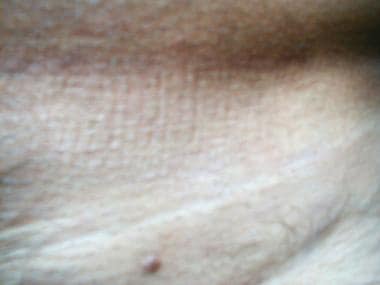Background
Condyloma acuminatum (also known as genital warts or anogenital warts) refers to an epidermal manifestation attributed to the epidermotropic human papillomavirus (HPV), as in the images below. [1, 2] More than 180 types of double-stranded HPV papovavirus have been isolated to date. Many of these have been related directly to an increased neoplastic risk in men and women.
Approximately 90% of condylomata acuminata are related to HPV types 6 and 11. These 2 types are the least likely to have a neoplastic potential. Risk for neoplastic conversion has been determined to be moderate (types 33, 35, 39, 40, 43, 45, 51-56, 58) or high (types 16, 18), [3] with many other isolated types. The picture is complicated by proven coexistence of many of these types in the same patient (10-15% of patients), the lack of adequate information on the oncogenic potential of many other types, and ongoing identification of additional HPV-related clinical pathology.
For example, bowenoid papulosis, seborrheic keratoses, and Buschke-Löwenstein tumors have been linked to HPV infections though they were previously a part of the differential diagnosis of condyloma acuminatum. Bowenoid papulosis consists of rough papular eruptions attributed to HPV and is considered to be a carcinoma in situ. The eruptions can be red, brown, or flesh colored. They may regress or become invasive. [4] Seborrheic keratoses previously were considered a benign skin manifestation. HPV has been linked to rough plaques indicative of this disease. It has both an infectious and an oncogenic potential. Finally, Buschke-Löwenstein tumor (ie, giant condyloma) is a fungating, locally invasive, low-grade cancer attributed to HPV. [5]
Pathophysiology
Cells of the basal layer of the epidermis are invaded by human papillomavirus (HPV). These penetrate through skin and cause mucosal microabrasions. A latent viral phase begins with no signs or symptoms and can last from a month to several years. Following latency, production of viral DNA, capsids, and particles begins. Host cells become infected and develop the morphologic atypical koilocytosis of condyloma acuminatum.
The most commonly affected areas are the penis, vulva, vagina, cervix, perineum, and perianal area. Uncommon mucosal lesions in the oropharynx, larynx, and trachea have been reported. HPV-6 even has been reported in other uncommon areas (eg, extremities).
Multiple simultaneous lesions are common and may involve subclinical states as well-differentiated anatomic sites. Subclinical infections have been established to carry both an infectious and oncogenic potential.
Consider sexual abuse as a possible underlying problem in pediatric patients [6] ; however, keep in mind that infection by direct manual contact or indirectly by fomites rarely may occur. Finally, passage through an infected vaginal canal at birth may cause respiratory lesions in infants. [6]
Epidemiology
Frequency
United States
Annual incidence of condyloma acuminatum is 1%. It is considered the most common sexually transmitted disease (STD). Prevalence has been reported to exceed 50%. Highest prevalence and risk is among young adults in the third decade and in older teenagers. A 4-fold or more increase in prevalence has been reported in the last 2 decades.
International
International prevalence has been reported variably. Available data from England, Panama, Italy, the Netherlands, and other developed and underdeveloped countries report HPV infections to be at least as common as in the United States.
Mortality/Morbidity
Mortality is secondary to malignant transformation to carcinoma in both males and females. This oncogenic potential has been reported to triple the risk of genitourinary cancer among infected males. Fortunately, this is rare with HPV types 6 and 11, which are the most commonly isolated viruses.
HPV infection appears to be more common and worse in patients with various types of immunologic deficiencies. Recurrence rates, size, discomfort, and risk of oncologic progression are highest among those patients. Secondary infection is uncommon.
Latent illness often becomes active during pregnancy. Vulvar condyloma acuminatum may interfere with parturition. Trauma then may occur, producing crusting or erythema. Bleeding has been reported in large lesions that can occur during pregnancy.
In males, bleeding has been reported due to flat warts of the penile urethral meatus, usually associated with HPV-16. Lesions may lead to disfigurement of area(s) involved. Finally, acute urethral obstruction in women also may occur.
Sex
Both sexes are susceptible to infection.
Overt disease may be more common in men (reported in 75% of patients); however, infection may be more prevalent in women.
Age
Prevalence is greatest in persons aged 17-33 years, with incidence peaking in persons aged 20-24 years. [7]
-
Genital wart in pubic area
-
Genital wart in pubic area (close-up view)
-
Genital wart in pubic area (very close-up view)
-
Genital wart in pubic area (look at bottom middle of picture)








